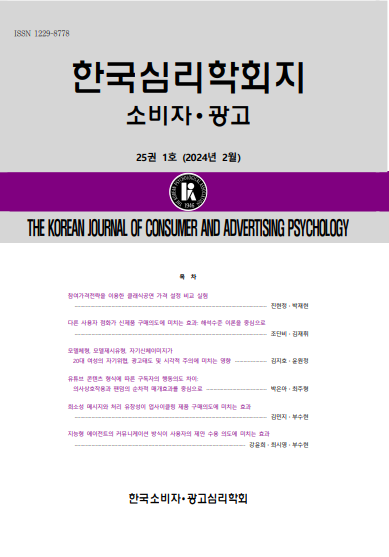open access
메뉴.png)
open access
메뉴 ISSN : 1229-8778
ISSN : 1229-8778
This study is mainly interested in identifying whether media use behavior and values on existing media are useful mediating variables in explaining the acceptance of IPTV. Therefore, this study employed three variables of consumer innovativeness, media use behavior and values on media and set up hypothetical model to find out how innovativeness affect IPTV acceptance being mediated by media use behavior and values on media. To test hypothetical model structural equation was employed. Results show that consumers' media innovativeness affects media use behavior and values on media. Media use behavior and values on media affect intention toward IPTV acceptance. In mediation effect, consumers' media innovativeness affects intention toward IPTV acceptance through the mediating effect of media use behavior and values on media. These results suggest that in today's multi-media environment consumer factors related with existing media should be carefully considered to explain and forecast intention toward IPTV acceptance.
강미선, 이수범 (2007). 다중매체 소비행동과 이용자 특성. 광고학연구, 18(4), 7-31.
강미은 (2000). 인터넷과 기존매체 이용의 상호 관계에 관한 연구. 방송연구, 여름호, 179-208.
강재원, 이상우 (2006). 다매체 환경에서 IPTV의 융합-수용 모델: 기능적 유사성과 미디어 대체를 중심으로. 한국언론학보, 50(2), 5-32.
김광재 (2009). DMB의 수용결정요인에 관한 연구. 한국언론학보, 53(3). 296-323.
김대호, 김도연, 김은미, 도준호 (2006). 초점집단 인터뷰를 통해 본 위성 DMB 초기 채택자의 채택동기 및 이용행태. 한국언론학보, 50(3), 65-93.
김병선 (2004). 재택 공간에서 미디어 대체 가능성의 재평가: 웹 이용과 텔레비전 시청 행위의 비교를 중심으로. 한국언론학보, 48(2), 400-429.
김신동 (2001). 호모텔레포니쿠스의 등장: 이동전화 확산에 영향을 준 사회문화적 요인연구. 한국언론학보, 45(2), 62-85.
김영주, 이화진 (2005). 모바일 콘텐츠의 채택요인과 잠재적 이용자 특성. 방송과 커뮤니케이션, 6(1), 168-203.
김철민 (2008). 광고상 수상 광고의 차별적 특징: 국내의 인쇄광고를 대상으로. 한국심리학회지 소비자, 광고, 9(3), 355-382,
김흥규, 윤용필 (2009). IPTV 채택 요인에 관한 수용자 연구: 실시간 채널 및 VOD 이용을 중심으로. 주관성 연구, 18, 5-23.
나은영 (2002). 여성의 뉴미디어 이용과 가치관: 이동전화와 인터넷을 중심으로. 한국방송학보, 16(2), 77-115.
디지털타임스 (2010). 2010. 4. 10일자.
박은아(2006). 다매체 이용자들의 미디어 동시사용행태: DMB 초기수용자를 중심으로. 한국방송학보, 22(1), 44-85.
박은아 (2008). 뉴미디어 초기수용의 영향요인에 관한 연구: 혁신성, 과시성향, 기기인식을 중심으로. 소비자학 연구, 19(1), 93- 113.
성동규, 조윤경 (2002). 이동전화 이용자의 집단적 특성에 따른 이용 유형 연구. 한국언론학보, 46(6), 153-190.
신명희, 안주아 (2005). 대학생 소비자의 라이프스타일 유형과 미디어 이용 및 구매행동에 미치는 영향. 광고학연구, 16(5), 111 -132.
심미선 (2007). 다매체 시대 미디어 레퍼토리 유형에 관한 연구. 한국방송학보, 21(2), 351-390.
심성욱, 박종민 (2004). 라이프스타일과 다양한 매체의 광고효과에 관한 인식. 광고학연구, 15(2). 7-33.
아주경제 (2010). 2010. 3. 30일자.
유세경 (2004). 텔레비전과 인터넷 이용행위의 상호관계성에 관한 연구. 한국방송학보, 18(3), 475-520.
윤승욱 (2009). IPTV의 수용결정요인에 대한 연구. 언론과학연구, 9(1), 162-197.
이상현, 유창조, 최성문 (2005). 라이프스타일 유형에 따른 화장품 구매행동과 추구가치에 관한 연구: 20대와 30대 여성을 중심으로. 한국심리학회지 소비자, 광고, 6(3), 79-99.
이상호, 김재범 (2007). 개인의 가치, 특성, 품질이 IPTV 양방향서비스 수용에 미치는 영향연구: TAM의 확장모형. 경영학연구, 36(7), 1751-1783.
이영수 (2008). IPTV, 부가서비스로 승부한다. LG Business Insight, (11월), 37-42.
이재신 (2007). 미디어 진화방향에 따른 IPTV 서비스 정책. 2007년 9월 한국언론학회 학술세미나 자료집, 33-56.
이재현 (2005). 인터넷, 전통적 미디어, 그리고 생활시간 패턴: 시간 재할당 가설의 제안. 한국언론학보, 49(2), 224-266.
이재현 (2006). 모바일 미디어와 모바일 콘텐츠: 멀티플랫포밍 이론의 구성과 적용. 방송문화연구, 18(2), 285-317.
이준웅, 김은미, 심미선 (2006). 다매체 이용자의 성향적 동기. 한국언론학보, 50(1), 252 -284.
이중식 (2005). DMB미디어 이용과 틈새시간에 관한 연구. 방송문화연구, 17(1), 207-228.
이찬구, 이종영, 성지연 (2009). 다매체 시대, 군집 유형에 따른 미디어 이용 방식에 관한 연구: 상대적 미디어 이용지수를 이용하여. 사이버커뮤니케이션학보, 26(3), 201 -242.
이학식, 안광호, 하영원 (2001). 소비자 행동: 마케팅 전략적 접근(3판), 서울: 법문사.
이화진, 김영주, 정재민 (2006). 위성 DMB 채택가능성에 영향을 미치는 요인에 관한 연구. 한국방송학보, 20(2), 237-273.
임성원 (2007). 미디어융합시대 방송 플랫폼의 경쟁구조 연구: 수용자 선택요인의 플랫폼별 적소비교를 중심으로. 한국방송학보, 21(3), 276-326.
조윤경, 정일권 (2007). 방송, 통신 이용성향이 DMB 채택에 미치는 영향: 인지된 유용성과 개혁성향을 중심으로. 한국방송학보, 21(5). 240-270.
한은정, 서보밀 (2010). 미디어 간 비교를 통한 IPTV 수용의 영향 요인 분석: 케이블방송, 위 성방송과의 비교를 중심으로. Enture Journal of Information Technology. 9(1), 45-60.
함창용, 오성백, 곽정호, 나상우, 천병준 (2008). IPTV시장의 국, 내외 현황 및 시사점. KISDI 이슈리포터, 1-63.
허다혜 (2009). 2009년 하반기 국내 IPTV 시장 동향. 방송통신정책, 21(22), 66-72.
Baron, M. Reuben., & Kenny, A. David. (1986). The moderator-mediator variable distinction in social psychological research: Conceptual, strategic, and statistical considerations, Journal of Personality and Social Psychology, 51(6), 1173 -1182.
Forrester Research Inc. (2006). Making broadband triple play profitable: IPTV revenues. Cambridge: Mass.
Goldsmith, R. E., & Hofacker, C. (1991). Measuring consumer innovativeness. Journal of the Academy of Marketing Science, 19(Summer), 209-221.
Joseph, B. and Vyas, J. (1984). Concurrent validity of a measure of innovative cognitive style. Journal of the Academy of Marketing Science, 12(2), 159-175.
Kathlyn E., & Villani, A. (1975). Lifestyle and television viewing behavior. Journal of Marketing Research, 12, 432-439.
Louis Leung (1998). Lifestyle and the use of new media technology in urban China. Telecommunications Policy, 22(9), 781-790.
Luna, D., & Gupta, S. F. (2001). An integrative framework for cross-cultural consumer behavior. International Marketing Review, 18(1), 45-69.
Reagan. J. (1987). Classifying adopters and non-adopters of four technologies using political activity, media use demographic variables. Telematics and Informatics, 4(1), 3-16.
Robertson, T. S. (1967). The process of innovation and the diffusion of innovation. Journal of Marketing, 31, 14-19.
Rogers, E. M. (1983). Diffusion of innovation. New York: The Free Press.
Rokeach, M (1973). The nature of human values. New York: Free Press.
Rubin, A. M. (1994). Media uses and effects: a uses and gratifications perspective, in J. Bryant & D. Zillmann (eds.), Media effects: Advances in Theory and Research, Hillsdale, NJ: Lawrence Erlbaum, 417-436.
Scott, J. E., & Lamont, L. H. (1973). Relating consumer values to consumer behavior: a model and method for investigation in increasing marketing productivity. Americal Marketing Association.
Walle M., & Theo W. M. (1986). Vacation market segmentation a domain-specific value approach. Annals of Tourism Research, 13(1). 37-58.